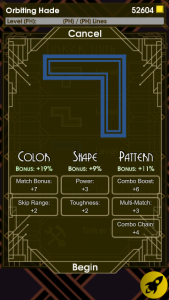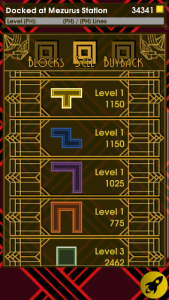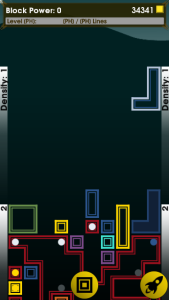SRG Update #9
For now I’ve got a placeholder UI in to let you select from anything you own that can be tinkered with. On the right you can see the initial/basic “item details” popup you see when you select such an item, letting you choose whether you want to work on that particular item or not.
Tinker Overview
So, quick overview of what this shows, and how it pertains to the current design of Tinkering.
First, when you tinker, you’re scored on three different aspects of your solutions – your color choices, how well you match the overall shape, and patterns you match while you do this. To some extent these three fight with one another, i.e., it’s hard to do well with patterns and colors at the same time.
Those scores translate into sets of related item improvements in a sort of “top score” way. So if you continually score exactly 4000 points on ‘Color’, eventually you will stop being able to improve color-related stats. You’ll have to improve your performance to refine those items further.
Generally, large gains in score will be uncommon, and driven more based on your characters’ leveling, items, and upgrades that you find or buy. For example, a Tinker module with 2 tinker “bays” (where blocks spawn) is significantly better than with just 1 tinker bay. When you can afford that second-tier Tinker module, you’ll find you can improve many of your items a fair bit more.
Score Bonuses
To complement these large, discrete gains, each time you tinker with an item you get small permanent bonuses to your score. That way, even if you don’t beat your old high score, at least you made some forward progress.
These permanent score bonuses are split: For now, 50% is applied to the tinker module itself, and 50% is applied to the item. This creates some inertia around specific items, but not too much. It also means when you get new items later in the game, you’re able to improve them much more rapidly than your initial attempts.
The score bonuses are not capped for now, though I may introduce some kind of diminishing returns on their scaling for balance purposes.
Three Tiers
I’m planning on having three tiers of Tinkering available:
- Tier 1, “Free”: Always available, the basic tinkering approach.
- Tier 2, “Metal”: As you gather valuable metal pips, you can use them for a boosted form of Tinkering. The cost depends on the item type… Tinkering with electronics might require copper or platinum, whereas tinkering with your hull might require iron or other space-y materials.Tier 2 tinkering provides a larger permanent score bonus (say, 5 or 10%, vs. 1% from Tier 1), as well as relaxing some of the constraints you normally face. This means you’re likely to get a higher overall score, or be better able to target something you’d found difficult before.
Additionally, I may add special stats that can only be improved through Tier 2 tinkering.
- Tier 3, “Elemental”: Elemental pips are very rare and have multiple uses, so you likely won’t use this mode often. When you do, though, you’ll get a very significant shift to permanent score bonuses, even more relaxed constraints, and other qualitative changes to enable you to achieve a much higher score than usual.As with Tier 2, it is likely that Tier 3 tinkering will offer unique stats to improve.
Ship Modules
Ship modules are expensive hardware you can acquire, giving your ship new capabilities. As with all other equipment, they can be tinkered with to improve their capabilities. (Yes, this even includes your Tinker module.)
All ships start with an intrastellar engine module, allowing you to travel between your starting star’s planets and their moons and/or space stations. Leaving the star will require an upgraded engine module. All ships also start with a basic mining module, allowing you to mine planets and moons you visit.
For the time being, the only module available for purchase is the Tinker Lab. Acquiring this enables the Tinker gameplay mode as described above. Of course, not all modules necessarily create new types of gameplay, but I hope to make them all have a significant qualitative effect on the game. E.g. if you buy a “hull armor” module, space combat should feel different afterwards, rather than just adding some number X to your current armor.
This same goal applies to module upgrades. E.g., upgrading your ship engine to second tier engine doesn’t just make you Y% faster in space – it allows you to jump between stars.
Those small stat changes are part of what Tinkering is meant to cover, so if you want to move around faster, that’s where to look.
Next Sprint (or 2 or 3…)
I’ll be implementing and testing the basic Tinker mode. Additionally, I’ll be splitting my time between BIS and another as-yet-unannounced game. I may switch from “BIS weekly reports” to general SRG progress reports, or perhaps alternate between the projects (so each has bi-weekly updates).
Until next time!


